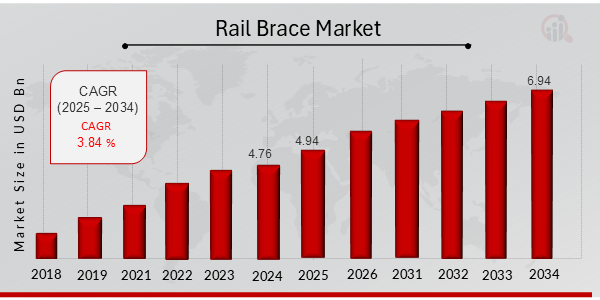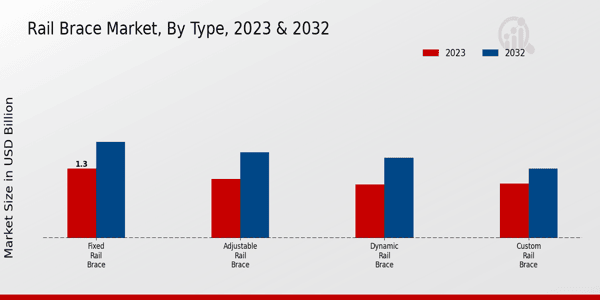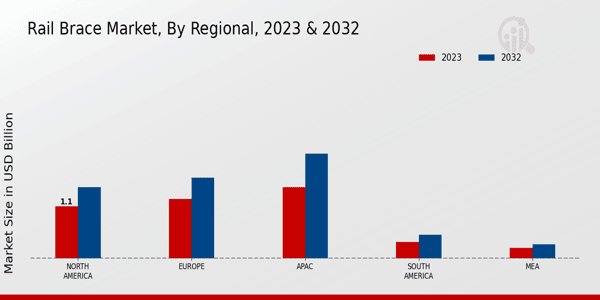Rail Brace Market Overview:
As per MRFR analysis, the Rail Brace Market Size was estimated at 4.76 (USD Billion) in 2024. The Rail Brace Market Industry is expected to grow from 4.94 (USD Billion) in 2025 to 6.94 (USD Billion) till 2034, at a CAGR (growth rate) is expected to be around 3.84% during the forecast period (2025 - 2034).
Key Rail Brace Market Trends Highlighted
The Rail Brace Market is experiencing notable growth fueled by increasing investments in rail infrastructure and modernization projects. One of the key market drivers is the rising demand for efficient and reliable public transportation systems.
As urban populations grow, there is a significant push for rail systems that can accommodate higher passenger volumes while reducing congestion in cities. Additionally, the shift towards sustainable transport solutions is encouraging governments and private sectors to invest in rail networks, further driving the market.
Opportunities in the Rail Brace Market are abundant, especially as countries focus on enhancing connectivity through high-speed rail and regional transit systems.
The push for regeneration of existing rail lines presents a chance for innovative rail brace technologies that improve safety and durability. There is also a growing interest in smart rail solutions, which incorporate digital technologies to monitor rail conditions and optimize maintenance schedules.
This creates new avenues for market participants to deliver advanced solutions that cater to evolving industry needs.
Recent trends indicate an increased focus on sustainability, with companies developing eco-friendly materials and smart manufacturing processes. Automation and digitization are gaining traction, leading to improved efficiency in production and maintenance.
Furthermore, collaborative efforts among manufacturers and rail operators are on the rise, strengthening supply chains and fostering innovation.
The integration of advanced technologies, such as artificial intelligence and big data, is reshaping operational practices, making them more efficient and responsive. This evolving landscape presents numerous opportunities for growth while meeting the pressing demand for safer and more efficient rail transport systems.

Source: Primary Research, Secondary Research, MRFR Database and Analyst Review
Rail Brace Market Drivers
Increasing Investments in Rail Infrastructure Development
The Rail Brace Market is significantly driven by increasing investments in rail infrastructure development across various regions. Governments and private sector stakeholders are recognizing the importance of modernizing rail networks to improve transit efficiency, safety, and reliability.
As urbanization accelerates and population density rises in major cities, there is an urgent need for enhanced public transportation systems. Railways are being strategically developed as an eco-friendly alternative to road transport, prompting additional funding and support for projects that aim to improve rail infrastructure.
During the forecast period, considerable efforts are expected toward the construction of new railway lines and the renovation of existing ones, which will inherently lead to heightened demand for rail braces, essential components that provide structural support and ensure system robustness.
Collaboration between governments, private partners, and international organizations in funding rail projects promotes favorable conditions for market growth. Notably, as countries emphasize sustainable transport modes and seek to reduce carbon emissions, investments are being steered towards technologically advanced rail systems that require high-performance rail brace products.
This trend aligns with global sustainability goals and encourages jurisdictions to adopt innovative solutions in rail construction and maintenance.
Consequently, this renewed infrastructure focus positions rail braces as critical components for supporting expansive networks, augmented through dedicated financing and strategic planning initiatives.
The rise in public-private partnerships and investment in modern technology for rail projects further fosters opportunities for the Rail Brace Market to flourish in an era characterized by rapid changes and advancements.
As plans materialize into actionable projects, the upsurge in demand for rail braces will trigger a positive ripple effect across the supply chain, promoting growth for manufacturers and suppliers across various segments within the rail sector.
Technological Advancements in Rail Systems
Technological advancements are pivotal drivers in the global rail brace market, presenting opportunities for innovation in design and functionality. The continuous evolution of engineering practices and materials science has led to the development of lighter, more durable, and cost-effective rail braces.
These advancements help improve the overall performance of railway systems, making them safer and more reliable. The incorporation of smart technologies, such as sensors and monitoring systems, provides real-time data to maintain optimal performance and ensure the longevity of rail systems.
Advances in materials like composites and alloys enable the production of rail braces that can withstand varying environmental conditions, thereby enhancing performance. As cutting-edge technologies are integrated into infrastructure improvements, the demand for modern rail braces will grow, further driving market expansion.
Rising Demand for Eco-Friendly Transport Solutions
The Rail Brace Market is witnessing a surge in demand due to a growing preference for eco-friendly transport solutions. As awareness of climate change and environmental sustainability increases, more people are opting for public transport over personal vehicles, which leads to greater usage of rail systems.
Governments around the world are investing in cleaner energy sources and sustainable transportation infrastructure, including railroads, that significantly reduce carbon footprints in urban scenarios.
This trend promotes the development of green rail technologies and encourages the adoption of solutions such as electric trains and energy-efficient rail systems, consequently boosting the need for advanced rail braces that support these modern applications.
Rail Brace Market Segment Insights:
Rail Brace Market Type Insights
Within this market, the type segment encompasses several crucial categories, including fixed rail brace, adjustable rail brace, dynamic rail brace, and custom rail brace.
The fixed rail brace held a significant position in the market, valued at 1.3 USD billion in 2023 and expected to grow to 1.8 USD billion in 2032. This growth is driven by the increasing demand for stability and safety in rail systems, making fixed rail brace a dominating force among the types available.
In contrast, the adjustable rail brace, valued at 1.1 USD billion in 2023 and expected to rise to 1.6 USD billion by 2032, offered flexibility that caters to various rail applications, thus showcasing its importance in accommodating varying rail needs.
The dynamic rail brace was another essential category, starting at a valuation of 1.0 USD billion in 2023 and expected to reach 1.5 USD billion in 2032. This type is particularly significant due to its application in scenarios that require adaptability to motion and forces exerted during operations.
It served a unique niche where resilience and strength are paramount, further contributing to the overall growth of the market.
Custom rail brace, with a value of 1.02 USD billion in 2023 and projected to extend to 1.3 USD billion by 2032, presented opportunities for tailored solutions across diverse rail systems, catering to specific client requirements and enhancing versatility in rail construction and maintenance.
The market dynamics reveal that fixed and adjustable rail braces dominate the landscape in terms of market share, reflecting the consistent demand for effective rail stabilization techniques. In contrast, the market for dynamic and custom rail braces, while smaller, still represents a significant opportunity for the industry to innovate and respond to specific challenges faced in rail operations.
The Rail Brace Market data indicates that investment in research and development for these specific types can lead to new advancements in rail safety and efficiency. Market growth in the Rail Brace Market is further fueled by trends emphasizing safety regulations and technological advancements in rail infrastructure, indicating forward momentum in improving operational reliability and longevity.
Overall, the diverse Type segment within the Rail Brace Market presents a comprehensive foundation for tackling the evolving demands and challenges faced by the rail industry today.

Source: Primary Research, Secondary Research, MRFR Database and Analyst Review
Rail Brace Market Material Insights
The Rail Brace Market showcases a diverse material segmentation that plays a key role in its growth. The market features several materials, including aluminum, steel, composite materials, and plastic, each contributing uniquely to the performance and durability of rail braces.
Among these, steel has a dominant influence due to its strength and resilience, making it essential for heavy-duty applications. Meanwhile, aluminum is recognized for its lightweight and corrosion-resistant properties, appealing to segments that prioritize efficiency and maintenance reduction.
Composite materials are increasingly favored for their ability to enhance performance while reducing overall weight, offering significant advantages in various rail conditions. Plastic, while holding a smaller share, is valued for its versatility and cost-effectiveness, particularly in less demanding rail applications.
As the market evolves, trends such as sustainability and the demand for lightweight solutions are expected to drive innovation across material types, impacting the overall Rail Brace Market revenue and further shaping the Rail Brace Market statistics in the coming years
Rail Brace Market Application Insights
The application segment is crucial as it comprises various functionalities essential for supporting rail systems. Within this segment, infrastructure support plays a vital role in maintaining the structural integrity of railways, ensuring the proper functioning of services.
Temporary support is increasingly significant as it addresses immediate needs during construction or repairs, providing utility in time-sensitive situations. Long-term support is important for sustaining the durability of rail assets over time, signifying its necessity in strategic planning and budgeting.
These segments together contribute to the market's resilience and adaptability to emerging challenges. The market growth is supported by infrastructure development initiatives and the rising need for efficient transportation solutions, which propels the demand for diverse application requirements within the Rail Brace Market revenue structure.
As the market evolves, trends such as sustainable practices and innovative technologies will shape the landscape, presenting further opportunities for growth and enhancement in this sector.
Rail Brace Market End Use Insights
The Rail Brace Market revenue is experiencing steady growth, particularly across various end-use sectors, which are instrumental to its overall development. The segmentation within the market includes diverse applications in residential, commercial, and industrial sectors.
The residential sector has been a major contributor, largely driven by increasing demand for safety in home constructions and renovations. In commercial applications, rail braces play a crucial role in ensuring structural integrity in buildings, particularly in high-rise constructions.
The industrial segment also holds a prominent position, characterized by the necessity for robust support systems in warehouses and manufacturing facilities. Market growth in these areas is supported by the rising emphasis on safety regulations and infrastructure upgrades.
While challenges such as fluctuating material costs persist, the overall opportunities for growth are expanding, particularly in emerging markets, facilitating a positive outlook for the global rail brace market. The combined influence of these factors makes the end-use segmentation vital to understanding the broader Rail Brace Market statistics.
Rail Brace Market Regional Insights
North America was significant in this market, with a valuation of 1.1 USD billion, showing robust demand and technological advancement, and expected to reach 1.5 USD billion by 2032. Europe closely followed, representing a prominent market with valuations of 1.25 USD billion in 2023, projected to increase to 1.7 USD billion, driven by extensive railway networks and government investments in infrastructure.
The APAC region dominated in terms of growth potential, currently valued at 1.5 USD billion and expected to rise to 2.2 USD billion, owing to rapid urbanization and increased passenger and freight transport demands.
South America and MEA, holding lower valuations at 0.35 USD billion and 0.22 USD billion, respectively, in 2023, were emerging markets with opportunities for expansion, expected to reach 0.5 USD billion and 0.3 USD billion by 2032 as investment in rail systems advances.
Overall, the insights reveal a diverse market landscape, with varying growth rates and opportunities influenced by regional dynamics and infrastructure strategies.

Source: Primary Research, Secondary Research, MRFR Database and Analyst Review
Rail Brace Market Key Players and Competitive Insights:
The Rail Brace Market has been experiencing notable growth driven by the increasing demand for rail transportation and the need for enhanced infrastructure. As nations seek to modernize their rail systems for efficiency, safety, and sustainability, a variety of companies compete in this sector to deliver advanced rail brace solutions.
The competitive landscape is characterized by a mix of established players and emerging companies, each striving to innovate in product design and performance. Elements such as technological advancements, strategic partnerships, and sustainability initiatives have gained importance as companies position themselves to capture greater market share.
Understanding the competitive insights within this market is essential for stakeholders looking to make informed decisions.
Kawasaki has established a strong presence within the global rail brace market, recognized for its engineering excellence and commitment to quality. With decades of experience in manufacturing rail vehicles and related components, Kawasaki leverages its deep technical expertise to offer innovative rail brace solutions that meet rigorous safety standards.
The company's emphasis on research and development enables it to stay ahead of market trends and customer needs, solidifying its reputation as a reliable supplier. Kawasaki's strengths also lie in its ability to integrate advanced technologies, such as high-strength materials and innovative manufacturing processes, which result in durable and high-performance rail braces.
Furthermore, its global reach allows Kawasaki to cater to diverse markets, positioning it as a formidable competitor within the industry. Similarly, Talgo has carved out a distinctive niche in the Rail Brace Market with its focus on lightweight and efficient rail solutions.
The company's dedication to innovation is evident in its unique approach to design, which emphasizes maximizing performance while minimizing material usage. Talgo's rail braces are renowned for their reliability, contributing to improved operational efficiency and safety for rail operators.
The company's strengths are further amplified by its commitment to sustainability, as Talgo continuously seeks to reduce the environmental impact of its products while enhancing the lifecycle of rail infrastructure.
Talgo's proactive engagement with clients and understanding of their specific requirements also bolsters its position in the marketplace, offering tailored solutions that enhance customer satisfaction and loyalty. Through these strategic initiatives, Talgo remains a key player competing effectively within the global rail brace market.
Key Companies in the rail brace market Include:
- Kawasaki
- Talgo
- Bharat Forge
- KnorrBremse
- Thales
- CRRC Corporation
- Hitachi
- Siemens
- Alstom
- Patil Railway Engineering
- Bombardier
- Wabtec
- Mitsubishi Heavy Industries
- General Electric
- Toshiba
Rail Brace Market Developments
Recent developments in the Rail Brace Market have seen significant activity among major players, including Kawasaki, Talgo, Bharat Forge, KnorrBremse, Thales, CRRC Corporation, Hitachi, Siemens, Alstom, Patil Railway Engineering, Bombardier, Wabtec, Mitsubishi Heavy Industries, General Electric, and Toshiba.
The market is witnessing increased investments in innovative technologies aimed at enhancing the efficiency and safety of rail systems. Notably, there are ongoing discussions regarding mergers and acquisitions within the sector.
Companies are looking to consolidate their market positions; for instance, Wabtec's strategic partnerships have been highlighted as essential for strengthening its supply chain capabilities. Additionally, Siemens has focused on expanding its footprint in the rail sector through various collaborative agreements.
Overall, the market valuation is on the rise due to heightened demand for rail mobility amid urbanization trends, with firms adapting by incorporating advanced manufacturing processes and materials for rail braces. These developments not only impact operational capabilities but also reflect a growing trend towards sustainability and reduced environmental footprints in rail transport solutions.
Rail Brace Market Segmentation Insights
-
Rail Brace Market Type Outlook
- Fixed Rail Brace
- Adjustable Rail Brace
- Dynamic Rail Brace
- Custom Rail Brace
-
Rail Brace Market Material Outlook
- Aluminum
- Steel
- Composite Materials
- Plastic
-
Rail Brace Market Application Outlook
- Infrastructure Support
- Temporary Support
- Long-Term Support
-
Rail Brace Market End Use Outlook
-
-
Rail Brace Market Regional Outlook
- North America
- Europe
- South America
- Asia Pacific
- Middle East and Africa
| Report Attribute/Metric |
Details |
|
Market Size 2024
|
4.76 (USD Billion)
|
|
Market Size 2025
|
4.94 (USD Billion)
|
|
Market Size 2034
|
6.94 (USD Billion)
|
|
Compound Annual Growth Rate (CAGR)
|
3.84% (2025 - 2034)
|
|
Report Coverage
|
Revenue Forecast, Competitive Landscape, Growth Factors, and Trends
|
|
Base Year
|
2024
|
|
Market Forecast Period
|
2025 - 2034
|
|
Historical Data
|
2019 - 2023
|
| Market Forecast Units |
USD billion |
| Key Companies Profiled |
Kawasaki, Talgo, Bharat Forge, KnorrBremse, Thales, CRRC Corporation, Hitachi, Siemens, Alstom, Patil Railway Engineering, Bombardier, Wabtec, Mitsubishi Heavy Industries, General Electric, Toshiba |
| Segments Covered |
Type, Material, Application, End Use, Regional |
| Key Market Opportunities |
Expansion in emerging markets, Innovative materials and technologies, Increased rail infrastructure investment, Growing demand for safety features, Integration with smart rail systems |
| Key Market Dynamics |
Growing infrastructure investments, Rising demand for safety, Technological advancements in manufacturing, Increasing rail freight transportation, Stringent regulatory standards |
| Countries Covered |
North America, Europe, APAC, South America, MEA |
Frequently Asked Questions (FAQ) :
The Rail Brace Market is expected to be valued at 6.94 USD billion by 2034.
The projected CAGR for the Rail Brace Market from 2025 to 2034 is 3.84%.
The APAC region is expected to have the largest market size at 2.2 USD billion in 2032.
The market value of Fixed Rail Brace is expected to reach 1.8 USD billion in 2032.
Key players in the market include Kawasaki, Talgo, Bharat Forge, KnorrBremse, and Thales.
The anticipated market value for Adjustable Rail Brace is 1.6 USD billion by 2032.
The Rail Brace Market was valued at 1.1 USD billion in North America for 2023.
The expected market size for Dynamic Rail Brace is anticipated to be 1.5 USD billion by 2032.
The market value of Custom Rail Brace was valued at 1.02 USD billion in 2023.
The estimated market value for South America is expected to be 0.5 USD billion by 2032.

















